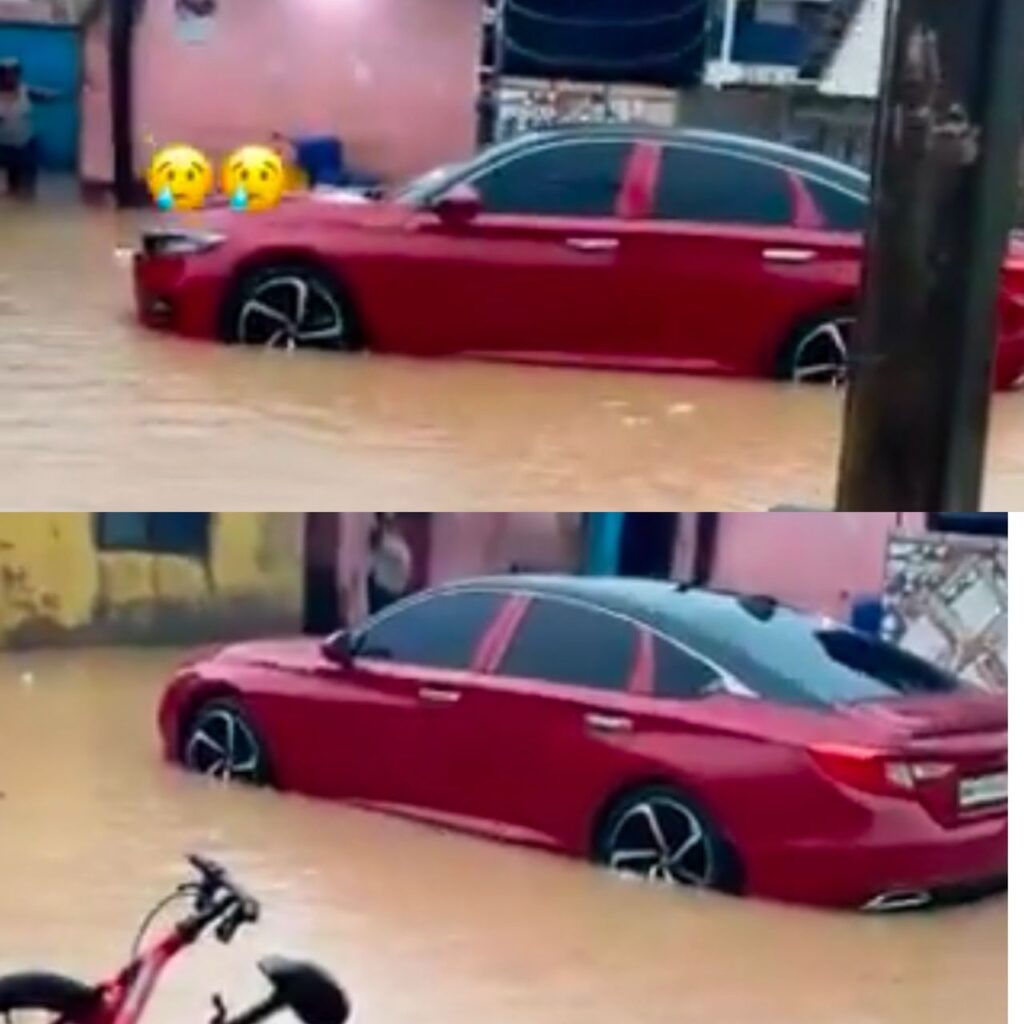While many people in Ghana anticipate the rainy season because it comes to reduce heat, and makes the environment greener and more comfortable, others, in places like Greater Accra and the Central regions, sit on tenterhooks awaiting destruction, due to the likelihood of floods and other disasters that occur as a result of rain.
A video circulating on social media on April 26, 2025, is a testament to this. In the video was a burgundy-colored Honda Accord that had been submerged halfway in a flood after a heavy downpour. The commentary that accompanied the video indicate the flood had moved the car from the spot where it was originally parked, and he was lost as to what to do next.

Since the rain started to rear its head once in a while before the month of May, several incidents of destruction have been recorded, with floods and heavy rainstorms occurring in certain parts of the nation, destroying properties, including cars. In March this year, a heavy downpour accompanied by rainstorms wreaked havoc at A&C Mall, damaging over 80 cars.
This goes to show how much enlightenment our drivers need in ensuring car safety in this season, where the rain is almost always pouring.
Safety precautions for drivers in the rainy season
You cannot prevent floods from occurring, but you can protect your car, whether you live in a flood-prone area or not. Here are a few tips to save your car from the floods.
Park in an elevated area
People who live in low-lying areas where flooding is common should park their cars on higher ground. To make sure your car is safe from waterlogging, use the parking space, even if it is far from your house. Due to their lower ground clearance compared to SUVs, owners of hatchbacks and sedans should pay particular attention to this issue.
Avoid driving through the most flooded part
The best course of action is to avoid driving through the water if your route, or a portion of it, is flooded or waterlogged when you get there. Drive gently along a path or side that seems to have less water. Keep an eye out for submerged impediments by waiting for a taller vehicle or a more courageous person to go ahead and give you an idea of how deep the pool of water might be. This lessens the possibility of your vehicle becoming trapped.
Check the gearbox and engine oil level
Examine the gasoline level on your dipstick. Should it exceed the typical level, it indicates that water has accidentally entered your engine. Ensure you clean your car’s motor oil, brake fluid, and transmission fluid. This is to ensure that when new fluid is introduced, the system will be free of impurities. Be aware that your engine may sustain significant harm if there is water in the motor fuel.

Drive slow, rev hard
To safely navigate waterlogged areas, drive at higher RPMs in lower gears to maintain a steady speed and avoid stalling. Avoid making a splash and power through flooded roads, as driving fast increases the risk of water seeping into the car’s engine bay or electricals. For cars with AMT or torque converter and dual-clutch automatic transmissions, switch to manual mode to ensure the car stays in the selected gear. Regular modes shift gears when revved, which is not ideal for driving through stagnant water.
In case if car stalls, do not start it
In the worst-case scenario, if your car has stalled in the midst of a flooded road and the water level is more than half the height of the tire, DO NOT START IT! It’s possible that the water has already seeped into the vehicle’s electrical or mechanical components or that it was drawn through the different holes during the combustion engine’s startup process, which requires air to be drawn in for the engine to run. Simply step out and watch for the water levels to decline.
Don’t start your automobile even if it’s parked and gets submerged up to the bumper. There is a good likelihood that the water got into the air filter or the engine. First, get it towed to the mechanic if necessary.
In addition to the immediate damage, the season brings to light the country’s inadequate drainage infrastructure once more. Due to clogged gutters and poor drainage management, water levels rapidly rise, rendering some flood-prone neighborhoods inaccessible. This lays a burden of caution on not just the government but us, as citizens, to do our best in reducing the rate at which our vicinities get flooded. Because at the end of the day, the cost of destruction lies on us to bear.




